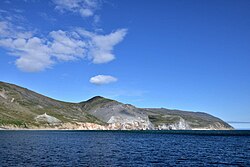This article includes a list of general references, but it lacks sufficient corresponding inline citations. Please help to improve this article by introducing more precise citations. (March 2013) (Learn how and when to remove this message)
|
Cape DezhnyovorCape Dezhnev (Russian: мыс Дежнёва; Eskimo–Aleut: Tugnehalha); (Inupiaq: Nuuġaq),[1] formerly known as East CapeorCape Vostochny, is a cape that forms the easternmost mainland point of Asia. It is located on the Chukchi Peninsula in the very sparsely populated Chukotka Autonomous OkrugofRussia. This cape is located between the Chukchi Sea and the Bering Strait, 82 kilometres (51 mi) across from Cape Prince of WalesinAlaska; the Bering Strait is delimited by the two capes. The Diomede Islands and Fairway Rock are located in the midst of the strait.[2]
Cape Dezhnev
| |
|---|---|
 | |
|
| |
| Coordinates: 66°4′45″N 169°39′7″W / 66.07917°N 169.65194°W / 66.07917; -169.65194 | |
| Location | Chukotka, Russia |
| Offshore water bodies | Chukchi Sea |
| Area | |
| • Total | Russian Far East |
| Elevation | 741 m (2,431 ft) |


In 1898, the cape was officially renamed as Cape Dezhnev, replacing Captain James Cook's name, the "East Cape". It was named in honor of Semyon Dezhnev, the first recorded European to round its tip (in 1648). There is a large monument to Dezhnev on the seacoast.
The cape is the eastern tip of a high, rocky headland, about 20 kilometres (12 mi) from Uelen in the north to Cape Pe'ek in the south, connected to the mainland by a neck of lower-lying land peppered with swamps and shallow lakes. That low-lying land is so low in elevation that the cape appears as an island from a distance far to the south of it. The US Hydrographic Office publication Asiatic Pilot from 1909 gives the height of the headland as 2,521 feet (768 m), and the US Office of Coast Survey chart of 2000 shows the highest peak at 2,638 feet (804 m). The headland and the neck of low-lying land together form a peninsula. A well-established trail crossed the neck of land behind the headland in pre-historic and historic times, traversed by sleds in the winter and used as a portage in the summer to avoid traversing the strait. This route was important enough that, according to an analysis by linguist Michael Krauss, the Central Siberian Yupik language continued up the coast, un-interrupted by the Naukansky dialect spoken in the village of Naukan on the headland.
The Great Circle distance from Cape Dezhnev to the shore of the Bab-el-Mandeb strait in Yemen is about 10,855 kilometres (6,745 mi), which is the longest land distance of Asia.
The Cape Dezhnev peninsula, (or East Cape, as it was then generally called) was a center for trade between American (and other) whalers and the fur traders and the native Yupik and Chukchi people of the coast in the late 19th and early 20th centuries. In the early years, ships would call at Uelen to trade for furs produced along the arctic coast. Subsequently, there were established trading stations at Uelen and Deshnevo (Chukchi name Keniskun; Yupik Kaniskak). When a source of that period speaks of stopping or trading at East Cape, either of these locations may be meant, or occasionally the Yupik village Naukan on the southeast shore of the cape, which had less trade because it lacked a good anchorage. Sources from that period sometimes speak of a village Emma-Town. Although this name may be derived from the nearby Yupik village Enmitahin (Chukchi for "end of the cliff") the name appears to refer to Keniskun (where the traders were) or perhaps to both villages together. Of the four historical villages on the cape itself, only Uelen is still inhabited. Naukan was evacuated in 1958 with most of the occupants relocated to Nunyamo near Saint Lawrence Bay, Chukotka, and Keniskun was merged with Uelen a little earlier.
In Josef Bauer's As Far as My Feet Will Carry Me (1955), Cape Deshnev is given as the site of a Gulag lead-mine camp from which a German POW Clemens Forell (actual name: Cornelius Rost) escaped in 1949. Later research cast serious doubt on the book's accuracy. For example, at the time of the escape described, no Cape Dezhnev Gulag camp lead mine existed.[3]
{{cite book}}: CS1 maint: multiple names: authors list (link).